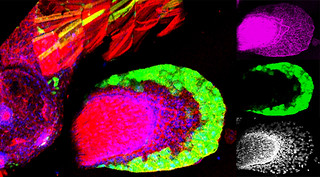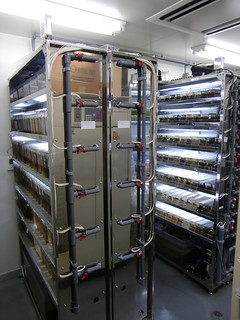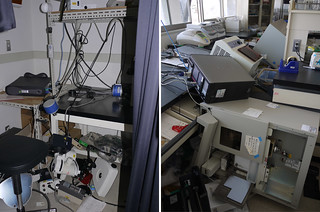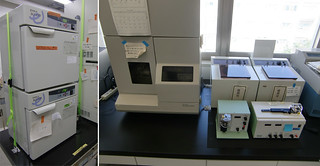Behind the Paper: Support beyond Countries
Posted by Tohru Yano, on 23 September 2012
 When Dr. Eva Amsen, Community Manager for the Node and Online Editor for Development, recommended me to write this post in connection with our recent publication about mechanisms of pectoral fin development in zebrafish, she was anxious to know the continuation of a story in Nature News last year after the earthquake (commented by my supervisor, Professor Koji Tamura, Tohoku University in Japan). We had almost forgotten our inexpressible anguish until Eva’s indication. Though it is true that we experienced a terrible disaster, what did we really suffer from? What kind of message should we give to readers? Although we decided to write this post about the road to publication of our article, I had hesitated to write it for a long time because I did not know from what I should begin to write.
When Dr. Eva Amsen, Community Manager for the Node and Online Editor for Development, recommended me to write this post in connection with our recent publication about mechanisms of pectoral fin development in zebrafish, she was anxious to know the continuation of a story in Nature News last year after the earthquake (commented by my supervisor, Professor Koji Tamura, Tohoku University in Japan). We had almost forgotten our inexpressible anguish until Eva’s indication. Though it is true that we experienced a terrible disaster, what did we really suffer from? What kind of message should we give to readers? Although we decided to write this post about the road to publication of our article, I had hesitated to write it for a long time because I did not know from what I should begin to write.
 Since our laboratory is located on a hill far from the sea, we were not directly affected by the tsunami, but the shock of the earthquake depressed us. Our fish room suffered from loss of power (for three days) and suspension of water supply (for three weeks). In other fish rooms in Tohoku University, many fish lines were lost because of low temperatures or damage caused by the earthquake. Fortunately, our fish room is located on the ground floor with air tightness maintained, I therefore decided to reduce feeding frequency to once every four days (to prevent water pollution) and reduce water circulation (to prevent excessive evaporation). When our water tank for fish became depleted of water after two weeks, we filtered water from a well at a place far from our fish room (the only place to obtain water in the campus) and we carried heavy plastic containers filled with water to the fish room. We were able to keep all of the fish lines alive (I had maintained the fish lines with tender care for six years from when I was an undergraduate student without the assistance of any fish technicians). Our laboratory also had other animals (frogs and reptiles) and most of them could be maintained, though some of them lost their ability to reproduce.
Since our laboratory is located on a hill far from the sea, we were not directly affected by the tsunami, but the shock of the earthquake depressed us. Our fish room suffered from loss of power (for three days) and suspension of water supply (for three weeks). In other fish rooms in Tohoku University, many fish lines were lost because of low temperatures or damage caused by the earthquake. Fortunately, our fish room is located on the ground floor with air tightness maintained, I therefore decided to reduce feeding frequency to once every four days (to prevent water pollution) and reduce water circulation (to prevent excessive evaporation). When our water tank for fish became depleted of water after two weeks, we filtered water from a well at a place far from our fish room (the only place to obtain water in the campus) and we carried heavy plastic containers filled with water to the fish room. We were able to keep all of the fish lines alive (I had maintained the fish lines with tender care for six years from when I was an undergraduate student without the assistance of any fish technicians). Our laboratory also had other animals (frogs and reptiles) and most of them could be maintained, though some of them lost their ability to reproduce.
 In our laboratory rooms (on the fifth floor of a six-story building), everything on the benches and desks fell down and many things were destroyed when the earthquake struck. We returned the fluorescence microscopes and DNA sequence analyzer back to their original positions, but they all fell onto the floor again when a big aftershock occurred. I remember that we were so depressed. The Japanese Government and Tohoku University provided money for repair. Four months later, we were able to restart experiments (though we could not concentrate on work immediately). Because of this chaotic period lasting for four months, submission of our manuscript to Development was delayed, and the PhD thesis defense was affected. Nevertheless, we received support from scientific communities all over the world. I was supposed to attend the JSDB-GFE Joint Meeting of Developmental Biology in Dresden (March 23-26, 2011), but I could not attend it. The German Society of Developmental Biologists supported our registration fee that we had cancelled. ZIRC (Zebrafish International Resource Center, USA) provided fish resources for us in order to allow us to restart experiments smoothly. In Japan, the CDB (Center for Developmental Biology) provided a shuttle bus to transport people and supplies. We received support from many people and organizations, and most of the costs for restoration were provided by public funds including donations from throughout the world. I appreciate this blessed environment, and consequently I could publish my article. However, there are still many people who are in need of support.
In our laboratory rooms (on the fifth floor of a six-story building), everything on the benches and desks fell down and many things were destroyed when the earthquake struck. We returned the fluorescence microscopes and DNA sequence analyzer back to their original positions, but they all fell onto the floor again when a big aftershock occurred. I remember that we were so depressed. The Japanese Government and Tohoku University provided money for repair. Four months later, we were able to restart experiments (though we could not concentrate on work immediately). Because of this chaotic period lasting for four months, submission of our manuscript to Development was delayed, and the PhD thesis defense was affected. Nevertheless, we received support from scientific communities all over the world. I was supposed to attend the JSDB-GFE Joint Meeting of Developmental Biology in Dresden (March 23-26, 2011), but I could not attend it. The German Society of Developmental Biologists supported our registration fee that we had cancelled. ZIRC (Zebrafish International Resource Center, USA) provided fish resources for us in order to allow us to restart experiments smoothly. In Japan, the CDB (Center for Developmental Biology) provided a shuttle bus to transport people and supplies. We received support from many people and organizations, and most of the costs for restoration were provided by public funds including donations from throughout the world. I appreciate this blessed environment, and consequently I could publish my article. However, there are still many people who are in need of support.
Earthquakes occur suddenly with almost no warning. After the earthquake, Koji decided to rearrange throughout the laboratory space and make anti-earthquake reinforcements. Both the number of casualties and the amount of money needed for restoration can be reduced by taking appropriate precautions against future possible disasters. It is also important to share experiences or information among scientists in order to be prepared for future disasters (the Node website is an advanced effort to communicate with developmental biologists/stem cell researchers throughout the world). We cannot thank you enough for your kindness!
We cannot thank you enough for your kindness!
Yano, T., Abe, G., Yokoyama, H., Kawakami, K. & Tamura, K. (2012). Mechanism of pectoral fin outgrowth in zebrafish development, Development, 139 (16) 2925. DOI: 10.1242/dev.075572


 (14 votes)
(14 votes)